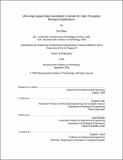Ultra-high-aspect-ratio nanofluidic channels for high-throughput biological applications
Author(s)
Mao, Pan
DownloadFull printable version (4.588Mb)
Other Contributors
Massachusetts Institute of Technology. Dept. of Mechanical Engineering.
Advisor
Jongyoon Han.
Terms of use
Metadata
Show full item recordAbstract
The development of micro/nanofluidics is expected to be the enabling technology for sample preparation of proteomic biosamples, which has been the bottleneck in proteomics. Most microfabricated nanofluidic channels, such as planar nanochannels and square nanochannels, suffer from small open volume and, as a result, low sample throughput, compared to microchips and conventional gel-based systems. For practical and wider applications of artificial nanochannels, it is of crucial importance to enhance sample throughput of nanofluidic systems. To address this severe problem, we proposed to build high-aspect-ratio vertical nanochannels, which have the advantage of large open volume, enabling their use for high-throughput applications. Two fabrication methods for creating massively-parallel, ultra-high-aspect-ratio nanochannels have been developed by using a combination of anisotropic wet etching and thermal oxidation. Vertical nanochannels with a uniform gap size of 55 nm and aspect ratio as high as 400 have been demonstrated. In addition, we have implemented high-aspect-ratio nanochannels into a two-dimensional anisotropic nanofilter array (ANA) device and demonstrated continuous-flow separation of DNA and proteins. Compared to other nanofilter devices, the vertical ANA device achieves comparable separation speed and efficiency but allows a much higher sample throughput. Lastly, we have demonstrated the uniform layer-by-layer deposition of polyelectrolyte multilayers (PEM) within high-aspect-ratio nanochannels. (cont.) Conformal, uniform deposition has been achieved along the entire depth of nanochannel and linear growth has been observed. Compared with the growth on flat substrate, significantly slower deposition per bilayer within nanochannels was found, which we attribute to the partioning effect. We also have performed dc conductance measurement to determine the wet-state thickness of PEM. The ability of uniform growth of PEM inside nanochannels not only allows the control of gap size, but also provides new functionalities with desired surface properties such as surface charge density, charge polarity, and hydrophobicity.
Description
Thesis (Ph. D.)--Massachusetts Institute of Technology, Dept. of Mechanical Engineering, 2009. This electronic version was submitted by the student author. The certified thesis is available in the Institute Archives and Special Collections. Cataloged from student-submitted PDF version of thesis. Includes bibliographical references (p. 131-133).
Date issued
2009Department
Massachusetts Institute of Technology. Department of Mechanical EngineeringPublisher
Massachusetts Institute of Technology
Keywords
Mechanical Engineering.